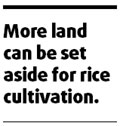Era of cheap rice is ending
(China Daily)
Updated: 2008-04-08 07:38
Updated: 2008-04-08 07:38
Shortages have doubled the international traded price of rice since January, from $400 a ton to $760 for the Thai benchmark variety.
India and Vietnam have applied supply curbs to preserve price stability, while the Thai commerce minister gave the trade a distortional boost by saying the price will reach $1,000 before long.
The makings of market strain are all over: Exporting nations ration sales to satisfy home demand and to curb inflation; farmers hold on to stocks for raised bids; shopkeepers hoard supplies to extract a premium from consumers, who in turn buy more than they need to.
Hoarders need reminding that weevils will get to the rice first in humid conditions if it is held for too long.

Singapore buys most of its rice from Thailand and Vietnam, both dependable suppliers. Provided importers and individual buyers can bear the higher cost, the market need not be disrupted. An assurance of supply is critical as it will shape market sentiment more than price, in this instance.
But some households have begun stocking up. The impulse should be resisted as import contracts have continued to be honored, though with mark-ups, and distribution throughout Singapore is even.
Consumer psychology, however, tends to be irrational. The assurance of uninterrupted supply should be reinforced by a doubling in the rice stockpile.
Stocks are good for three months' consumption at a crunch. Make it six months worth and see if the people would not feel doubly assured.
But Singaporeans need to be apprised of a fundamental change in the rice trade so as not to be thrown into a panic by spiking prices.
Until the end of 2006 rice held steady at $300 a ton while other crops such as wheat and maize were setting records, due partly to the unseemly haste to use certain crops for biofuels.
Last year's run of bad weather in China, Australia and the Indochina states reduced rice output.
There was also cropland damage in many countries, a serious matter as it takes several years to bring land into production. Bad weather is a variable factor. More land can be set aside for rice cultivation.
Consumers should brace themselves for the prognosis: The era of cheap rice is ending.
The Straits Times/Asia News Network
(China Daily 04/08/2008 page9)
|
|
|
|